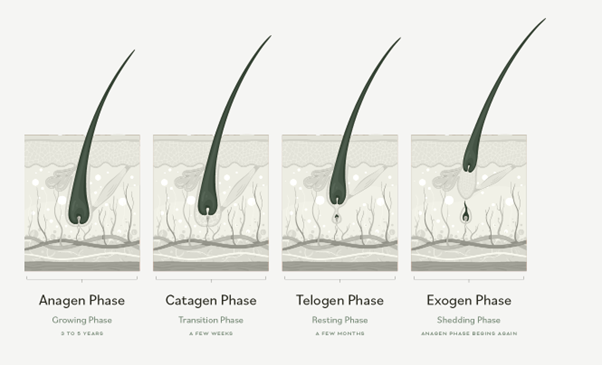Hair growth is a dynamic and intricate process. Each strand on our body experiences a cyclical journey of growth, dormancy, and eventual shedding. It’s perfectly natural to lose approximately 50-100 strands daily, a fact many become aware of during grooming routines like combing or showering.
The magic starts with the hair follicles, tiny structures beneath our skin. These follicles not only produce hair but also ensure they receive vital nutrients and blood supply.
Let’s break down the crucial phases of the hair growth cycle:
Diving Deep into the Hair Growth Cycle
The life of a hair strand is defined by its cyclical journey through various stages. Let’s explore each phase in detail:

1. Anagen Phase (Growth Phase):
– This is the active growth phase where hair strands are rapidly growing.
– It can last anywhere from 2 to 7 years, with hair growing about half an inch per month.
– At any given time, about 85-90% of the hairs on one’s head are in this phase.
2. Catagen Phase (Transition Phase):
– Following the Anagen phase, hair enters the Catagen phase which is relatively short, lasting about 2-3 weeks.
– During this time, hair growth slows and the outer root sheath shrinks, detaching the hair from its blood supply.
– This essentially prepares the hair to enter the resting phase.
3. Telogen Phase (Resting Phase):
– This phase lasts around 3 months.
– Hair growth has completely halted, and no pigment is produced.
– Roughly 10-15% of all hairs on one’s head are in the Telogen phase at any one time.
– At the end of this phase
4, The Exogen Stage – During this stage, the hair eventually sheds.
After remaining anchored in the skin for a while, the hair strand separates from its follicle and drops out. Subsequently, a new hair starts to emerge, marking the beginning of the Anagen stage once more.

The Cycle of Hair Growth and Its Connection to Male Pattern Baldness
Male Pattern Baldness (MPB), also referred to as Androgenetic Alopecia, is a prevalent issue in men. It’s characterized by hair loss starting from the hairline or the top of the head.
To truly grasp the effects of MPB, one must first understand the basic life cycle of hair.
The hormone Dihydrotestosterone (DHT) plays a pivotal role in Male Pattern Baldness. The influence of DHT on hair follicles varies based on one’s genetic susceptibility to hair loss. DHT generally causes hair follicles to diminish, weaken, and eventually halts them from producing robust new hairs.
With each hair growth cycle, DHT causes the follicles to reduce in size, leading to progressively finer hairs. Ultimately, the hair becomes so thin that it can’t even penetrate the skin’s surface, resulting in baldness.
Suspect You Have Male Pattern Baldness?
If you believe you’re dealing with Male Pattern Baldness, you’re likely curious about potential solutions. Fear not, we’re here to help.
Visit our article titled ‘Addressing Male Pattern Baldness: What Are My Options?’ to discover the information you need.
This piece of information is intended for informational use only and does not serve as a replacement for professional medical counsel. Always consult with your physician to understand the risks and advantages of any hair loss remedy.